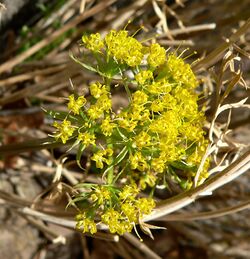Biology:Lomatium parryi
| Lomatium parryi | |
|---|---|

| |
| Flower cluster | |
| Scientific classification | |
| Kingdom: | Plantae |
| Clade: | Tracheophytes |
| Clade: | Angiosperms |
| Clade: | Eudicots |
| Clade: | Asterids |
| Order: | Apiales |
| Family: | Apiaceae |
| Genus: | Lomatium |
| Species: | L. parryi
|
| Binomial name | |
| Lomatium parryi (S.Wats.) J.F.Macbr.
| |
Lomatium parryi, commonly known as Parry's biscuitroot and Utah desertparsley, is a perennial herb in the carrot family. It is a common herb in high altitude areas of deserts and common in desert National parks, such as Death Valley mountains, in the western part of the United States .
The species epithet parryi honors Charles Christopher Parry (1823-1890), the first official botanist for the U.S. Department of Agriculture and a collector with the Pacific Railway Survey. He participated in numerous survey expeditions to the American West, during which he gathered various species previously unknown to the scientific community.[1]
Description
Lomatium parryi is a plant that grows from a taproot low to the ground, featuring small leaflets.[2] The flowering stems are usually stout or and with hollow internodes. The plant grows 20 to 40 centimeters tall. The hairy, basal leaves are divided into many small segments. The yellow flowers, which are visible in late winter and early spring[2] and are easily overlooked due to their tiny size, are borne in an umbrella-like pattern known as an "umbel."[1]
The flowers exhibit 8 to 15 ray florets and five prominent stamens, all of them measuring just a few millimeters. Below each cluster of flowers at the end of the pedicels, you may find 3 to 8 bractlets, which can be either whole or divided.[3] Like most other plants, the flowers are pollinated by insects, which cause winged seeds to appear.[2]
The fruits are schizocarp, which are flat and wide with lateral wings. They split into two halves, each one seeded. Lomatium parryi often retains its previous year's dead leaves and flower stalks, underscoring its resilience and ability to adapt over time.[3]
Uses
Lomatium parryi is a plant related to celery and carrots within the Apaceae family that's roots were harvested and consumed by early Native Americans.[2] Early documentation suggests that Native American tribes turned to these plants as part of their traditional medicine practices, with reportedly positive results during the influenza pandemic of 1917.[4] With this evidence, there was an increased interest in native plant medicine during the COVID-19 pandemic as people were exploring ways to strengthen their immune systems.[5]
Moreover, it's worth noting that Lomatium parryi serves as a vital larval host plant for several Papilio indra subspecies in their natural habitats and is a suitable food source in laboratory settings for rearing nearly all Papilio indra subspecies.[6]
References
- ↑ 1.0 1.1 Moab Happenings archive. (n.d.). https://www.moabhappenings.com/Archives/Nature1103EarlySpringFlowers.htm
- ↑ 2.0 2.1 2.2 2.3 Red Rock Canyon Las Vegas. (2019, March 20). Flower Friday: Parry’s lomatium. Red Rock Canyon Las Vegas. https://www.redrockcanyonlv.org/flower-friday-parrys-lomatium/
- ↑ 3.0 3.1 Southwest, T. A. (n.d.). Lomatium parryi, Parry’s biscuitroot. The American Southwest. https://www.americansouthwest.net/plants/wildflowers/lomatium-parryi.html
- ↑ Drug encyclopedia. Drug Encyclopedia | Kaiser Permanente. (n.d.). https://healthy.kaiserpermanente.org/health-wellness/drug-encyclopedia
- ↑ Seeds, K.-S. N. (2020, March 26). The power of lomatium. Klamath Siskiyou Native Seeds. https://klamathsiskiyouseeds.com/2020/03/25/the-power-of-lomatium/
- ↑ Lomatium parryi. Papilio indra Swallowtail Butterflies. (n.d.). https://papilioindra.org/larval-foodplants/lomatium-parryi/
External links
- Jepson Manual Treatment
- USDA Plants Profile
- Arches National Park, 2007 from National Park Service (NPS)
- Photo gallery
Wikidata ☰ Q6669264 entry
 |


